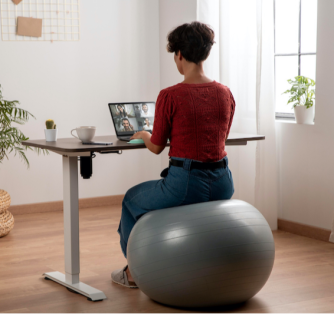Menu
Weight loss
Hormones
Sex
EXPLORE
MEET NU IMAGE MEDICAL
TREATMENTS
MEET NU IMAGE MEDICAL
TREATMENTS
MEET NU IMAGE MEDICAL
Benefits of Sitting on a Stability or Yoga Ball at Work


Sitting on a stability ball, also known as an exercise or yoga ball, at work can offer a variety of benefits. Here are some of the potential advantages:
Improved posture: Sitting on a stability ball requires more engagement of the core muscles, which can help improve posture and reduce back pain.
Increased balance and stability: Sitting on a ball requires constant adjustments to maintain balance, which can help to strengthen the core and improve overall balance and stability.
Increased calorie burn: Sitting on a stability ball requires more energy than sitting in a chair, which can help to burn a few extra calories throughout the day.
Improved circulation: Sitting on a stability ball can promote better blood flow throughout the body, which can help to reduce the risk of blood clots and other circulation-related health issues.
Reduced stress on joints: Sitting on a stability ball can reduce pressure on the hips and lower back, which can be beneficial for individuals with joint pain or other musculoskeletal conditions.
Increased focus and productivity: Sitting on a stability ball can help to improve alertness and focus, which can lead to increased productivity and improved work performance.
It is important to note that sitting on a stability ball is not appropriate for everyone. Individuals with certain medical conditions or balance issues may not be able to safely use a stability ball as a chair. Additionally, it is important to use the stability ball correctly and with proper form to avoid injury.
The Biomechanics of Sitting
Sitting is a common activity that many of us engage in for extended periods of time throughout the day. However, sitting for prolonged periods of time can have negative effects on our posture, musculoskeletal health, and overall well-being. Here are some of the biomechanics of sitting:
Spinal alignment: When sitting, it is important to maintain a neutral spine with a slight curve in the lower back. Slouching or leaning forward can put undue pressure on the spinal discs and lead to back pain or other spinal issues.
Pelvic position: The position of the pelvis when sitting can affect the alignment of the spine and the engagement of the core muscles. Sitting with a tilted pelvis or a slumped posture can contribute to poor posture and back pain.
Weight distribution: Sitting with equal weight distribution between both hips can help to reduce pressure on the hips, knees, and ankles. Unequal weight distribution or crossing one leg over the other can contribute to musculoskeletal issues and joint pain.
Arm and shoulder position: Sitting with arms and shoulders in a relaxed, neutral position can help to reduce tension and strain in the upper back, neck, and shoulders.
Foot position: Placing feet flat on the ground can help to reduce pressure on the lower back and maintain stability while sitting.
Movement: It is important to take frequent breaks from sitting and to incorporate movement and stretching throughout the day to reduce the negative effects of prolonged sitting.
In conclusion, sitting on a stability ball at work can offer several potential benefits for posture, balance, calorie burn, circulation, joint health, focus, and productivity. However, it is important to use the stability ball safely and correctly and to consult with a healthcare provider before making any changes to your workstation setup.
Sitting is an important activity that can have significant effects on our posture, musculoskeletal health, and overall well-being. By maintaining proper spinal alignment, pelvic position, weight distribution, arm and shoulder position, foot position, and incorporating movement throughout the day, we can reduce the negative effects of prolonged sitting and promote better health and well-being.
This article is for informational purposes only and does not constitute medical advice. The information contained herein is not a substitute for and should never be relied upon for professional medical advice. Always talk to your physician about the risks and benefits of any treatment. Nu Image Medical may not offer the medications or services mentioned in this article.
